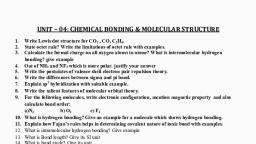Question 2 :
A substance 'P' does not have a fixed , volume. It occupies the total space of the container and it can be compressed. What is 'P' likely to be?
Question 3 :
The kinetic energy of the particles will be minimum in _______.
Question 4 :
Density ratio of <img style='object-fit:contain' src='https://storage.googleapis.com/teachmint/question_assets/JEE%20Main/5e798605c6cb6261b35b3167' height='20' width='21' > and<img style='object-fit:contain' src='https://storage.googleapis.com/teachmint/question_assets/JEE%20Main/5e798606adb2ea6185a769c2' height='20' width='23' > is 16 : 1. The ratio of their r.m.s. velocities will be
Question 5 :
Which of the following expression correctly represents the relationship between the average kinetic energy of CO and N<sub>2</sub> molecules at the same temperature.
Question 7 :
In which of the following, central atom does not have one lone pair of electron?
Question 12 :
In which of the following species is the underlined carbon having {tex} s p ^ { 3 } {/tex} hybridisation?
Question 13 :
An ether is more volatile than an alcohol having the same molecular formula. This is due to[2003]
Question 16 :
Which of the following is affected by the stable electron configuration of an atom ? <br>(A) Electronegativity <br>(B) Ionisation enthalpy <br>(C) Electron gain enthalpy<br>Correct answer is:
Question 18 :
The set representing the correct order of first ionization energy is
Question 20 :
What is the atomic number of last member of the seventh period of the extended form of periodic table?
Question 22 :
Li resembles Mg due to diagonal relationship, which is attributed to :
Question 23 :
The first element of a group differs in many ways from the other heavier members of the group. This is due to :
Question 24 :
In which of the following arrangements the order is NOT according to the property indicated against it ?
Question 26 :
The plots between P and V which represent isochoric and isobaric process respectively:<br><img style='object-fit:contain' src='https://storage.googleapis.com/teachmint/question_assets/JEE%20Main/5e7986e3c6cb6261b35b3605' height='160' width='187' >
Question 28 :
Consider the given diagram for 1 mole of a gas X and answer the following question. <br><img style='object-fit:contain' src='https://storage.googleapis.com/teachmint/question_assets/JEE%20Main/5e798589adb2ea6185a76642' height='100' width='115' ><br>The process A<img style='object-fit:contain' src='https://storage.googleapis.com/teachmint/question_assets/JEE%20Main/5e798589adb2ea6185a76643' height='15' width='19' >B represents
Question 29 :
A system is provided 50 joule of heat and the change in internal energy during the process is 60 J .work done on the system is :
Question 31 :
Which one of the following pairs of elements does not have diagonal relationship?
Question 33 :
Which one of the following orders presents the correct sequence of the increasing basic nature of the given oxides
Question 34 :
The set representing the correct order of first ionisation potential is :
Question 36 :
Which of the following compounds on thermal decomposition yields a basic as well as an acidic oxide?
Question 39 :
Which of the following on thermal decomposition yields a basic as well as acidic oxide ?
Question 43 :
The ionic mobility of alkali metal ions in aqueous solution is maximum for
Question 46 :
Out of the following, the alkene that exhibits obtical isomerism is
Question 47 :
How many enantiomer pairs are obtained by monochlorination of {tex} 2,3 {/tex} -dimethylbutane
Question 48 :
What is the possible number of optical isomers for a compound containing {tex} 2- {/tex} dissimilar asymmetric carbon atom
Question 51 :
Which types of isomerism is shown by {tex} 2,3 {/tex} -dichlorobutane
Question 55 :
The IUPAC name of the compound shown below is :<br><img style='object-fit:contain' src='https://storage.googleapis.com/teachmint/question_assets/JEE%20Main/5e7995f6d3f9ab617fcdc9cd' height='94' width='115' ><br>
Question 56 :
The isomers which can be converted into another forms by rotation
of the molecules around single bond are
Question 58 :
The number of possible alcoholic isomers for {tex}\mathrm {C _ { 4 } H _ { 10 } O} {/tex} are


















































